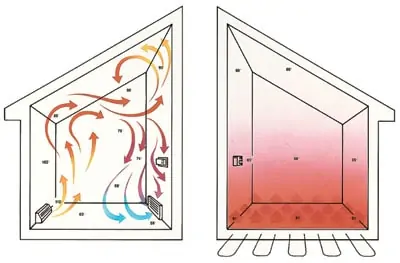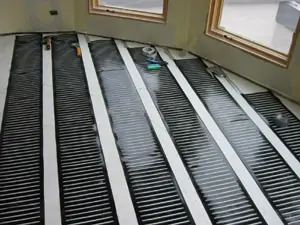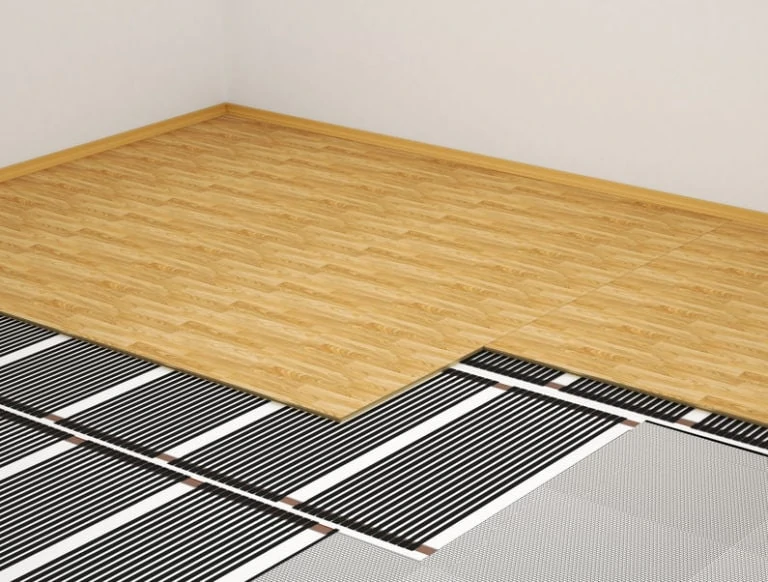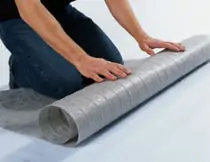Radiant heat floor systems combine comfort and energy efficiency.
You might have heard this in science class: Heat rises. And a source of heat at your feet is a great way to stay warm during winter. Rather than using air currents, radiant heat floor systems provide direct heat, similar to standing in the sunlight on a chilly day. When your entire floor is heated to 72 degrees it becomes a large radiating surface that generates heat outward to all areas of the room. A heated floor does a great job warming you up from toe to head, making the home comfortable enough for bare feet in the middle of a cold spell.
Radiant floor heat offers several key benefits. The systems cost less to operate and produce less dust than forced-air systems. Silent operation is another bonus. Plus, today’s systems have simple yet incredibly smart controls that can target and maintain the level of comfort in specific areas of the home. They can also go under most types of flooring, including wood, carpet, stone, tile and laminates.
Radiant floor systems have actually been around for about 2000 years. In the “Dark Ages” the Romans used a similar system, where a fire below the living space was used to heat channels that ran beneath the floors. Well, technology has changed.

(Images courtesy of Uponor)
Hydronic Systems
Today there are two types of radiant heat floor systems: Hydronic and Electrical. Hydronic systems generally feature under-floor pipe that carries hot water across the floor. The flowing hot water provides the floor’s pervasive warmth. These systems are usually installed in new-construction applications. Hydronic systems can be powered by gas, oil, electricity or solar energy, making them more flexible and economical than electrical systems, when used for whole-house applications.

Years ago, hydronic systems were built with metal tubing placed in a concrete slab. Unfortunately, as the concrete shifted and cracked over time, so did the pipes. Today most modern hydronic systems are made of PEX tubing (cross-linked polyethylene) and rubber tubing that can take more stress and strain than the metal tubing used in older systems. The cross-linking process makes the tubing very strong at high temperatures, and the flexible plastic moves with the natural movement and settling of the house, without leaking or cracking.
The hydronic tubing is usually embedded in a concrete slab or a 1-1/2-inch-thick concrete overlay on top of a wood floor. It can also be suspended in the space below wooden floors or stapled on top of subfloors. But a concrete installation provides better soundproofing and fireproofing, as well as adds stability and protection to the tubing. Almost all tubing for hydronic systems is guaranteed for 25 years, with a lifetime expectancy of 100 years. The best bet for longevity is that the tubing be installed by an experienced radiant floor contractor.
Electrical Systems
Electrical radiant heat systems use mortar-embedded cable or thin under-floor mats that are wired to work much like electric blankets. These systems are often used to heat small areas such as kitchens, bathrooms and entryways. Electrical systems are typically easier to install than hydronic systems. They work well in many single-room remodeling projects because many existing homes have electric heat, so it’s easier to maintain the same energy source.
Electrical systems offer the easiest installation. In some cases, just lay an underlayment, lay the heating mats, connect to the power source and install the flooring. (Photos courtesy of NuHeat)
Before installing any electrical floor system, first create a layout plan to determine the materials required. Make notes of exact room measurements, placement and number of heating elements, length and wattage per element strip, location of power source and electrical boxes, as well as any other information that will facilitate the installation. Be sure the floor is prepared and clean. Most heating elements can be installed over any dry, clean, non-conductive and structurally sound surface. Thermal insulation is often installed with the heating elements. All electrical systems come with detailed installation instructions, but the systems don’t all install exactly the same. Refer to your manual for specifics.

The Right System for You
In the case of constructing a new home, a hydronic system will likely be the best choice for use as a sole source of heat for the whole house. If you’re building a new home and want to use radiant heating to “spot warm” the home, hydronic may still be your best bet, but the final decision may depend on the difference in cost. Compare prices for both types and explore the varying products on the market before spending your money.
Electrical systems may be your best option when remodeling. For one thing, hydronic floor systems can elevate the floors by a couple of inches. However, some thin electrical systems only elevate the floor by about 1/8 inch.
Also, the concrete slab of a hydronic system can take a few hours to heat up once it has been turned on. Electrical systems, on the other hand, usually take between 30 minutes and an hour to heat up. In most cases, electrical systems are governed by a timer and a thermostat that homeowners preset with on/off cycles.

While the electricity cost of generating 1,000 BTU’s may be cheaper with a hydronic system than with an electrical one, the way the systems operate plays a major role in energy costs. Hydronic systems are generally left on for a period of months to accommodate the lengthy heat-up time of the systems. Electrical systems are usually timed to switch on and off according to when the homeowners will be at their house. The many “off” sessions cut down the cost of electricity. So consider your lifestyle and how you will be using the heating system.
Cost of installation depends on the nature of the job. For remodeling projects or single-room installations in new homes, hydronic systems will cost more to install. However, in large jobs such as whole-house applications in new construction, a hydronic system will cost less. Electrical systems are definitely more user-friendly for the DIY remodeler.
Whether hydronic or electric, radiant heat floor systems offer the popular combination of comfort and energy efficiency. The Radiant Panel Association, the trade organization for the radiant heating industry, estimates that these systems can reduce a home’s energy usage by 25 to 30 percent when compared to forced-air systems. Warm feet and more money in your pocket—that’s a good combination.

Radiant Floor Heat: How it Works
Every home—no matter how well insulated—is constantly losing heat to the outside, and forced-air heating systems are constantly working to replace this lost heat. Similarly, our bodies also lose heat to the colder objects that surround us. Heat always flows toward cold, and this loss of body heat causes us to feel chilly.
Radiant floor systems work so efficiently because they directly heat objects in the room instead of just the air in the room. It warms you, the floor, the sofa, the recliner, the kitchen table, etc. Since these objects are warmer, they don’t sap as much heat. The end result is an overall feeling of warmth and comfort. In fact, the air temperature in the room can be considerably lower if your body is in a room full of warm objects, and you’ll still feel very comfortable. Many people who use radiant heat lower their thermostats to 65 degrees and feel more comfortable than they did when setting their conventional heating system to 70-72 degrees.
Radiant Resources
Some prominent Radiant Floor Heating companies include:
EasyHeat uses electrical heating cables to provide solutions for pipe-freeze protection, roof/gutter de-icing, radiant floor heating and snow-melting. (860) 653-1600, https://www.emerson.com/en-us/commercial-residential/easyheat
Heatizon is a leader in luxury radiant heating, radiant snow melting, radiant roof snow melt and deicing, and radiant floor warming systems. 1-888-239-1232, www.heatizon.com
NuHeat is one of the top-selling radiant floor heating systems. Pre-built like an electric blanket, the Nuheat system is perfect for bathrooms, kitchens, entryways and even granite countertops. 1-800-778-WARM, www.nuheat.com

Step Warmfloor is a radiant heat system that uses a patented electro plastics element for a comfortable, even heat. It is billed as the only low-voltage (24-volt, AC or DC) self-regulating system available. 1-877-783-7832, www.warmfloor.com








